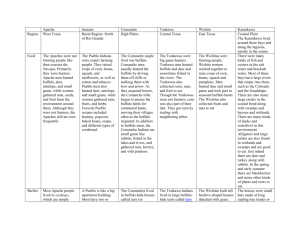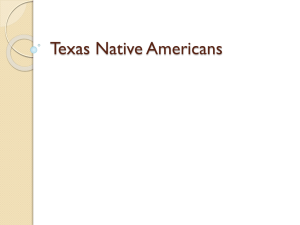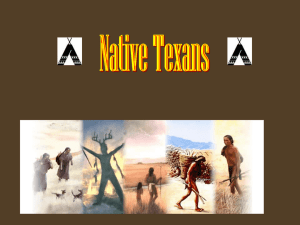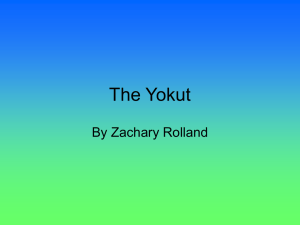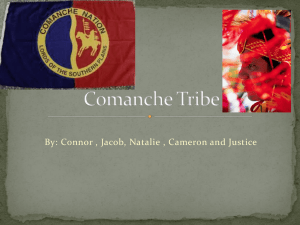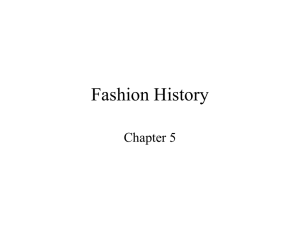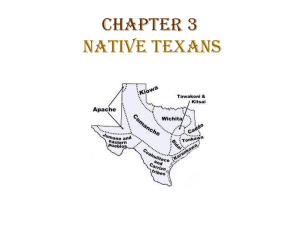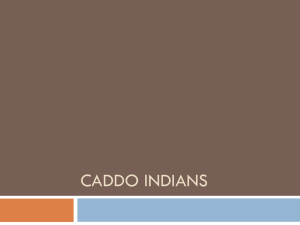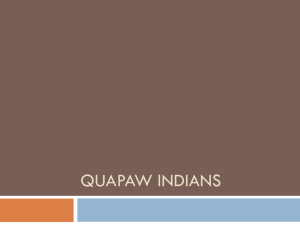9082-20121015020333
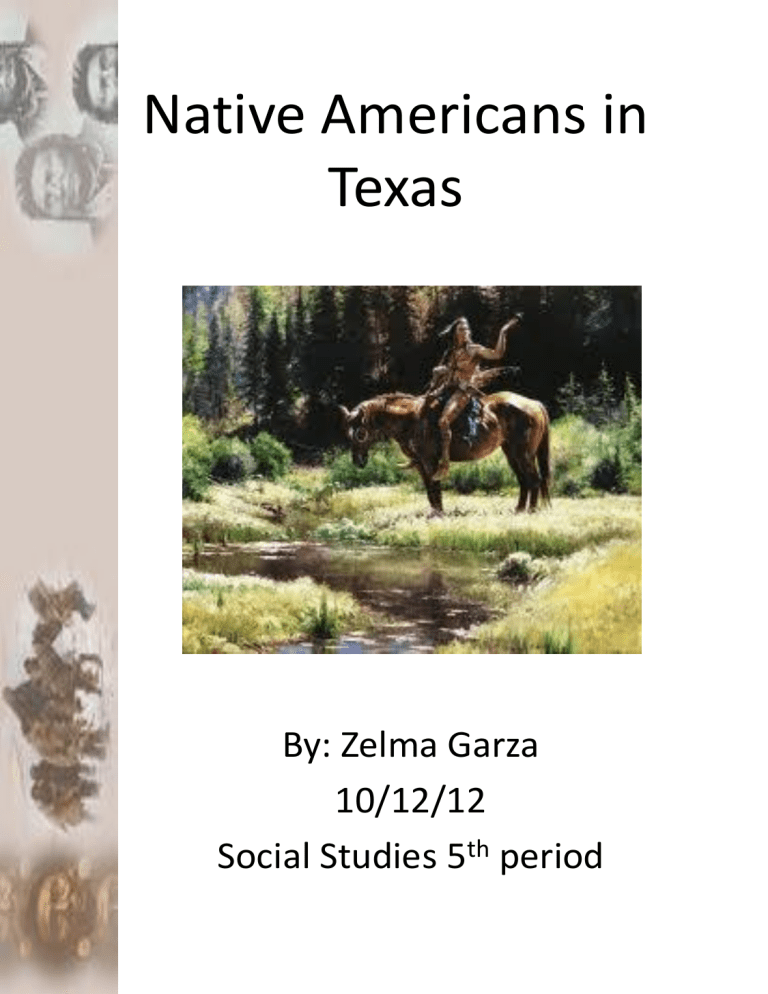
Native Americans in
Texas
By: Zelma Garza
10/12/12
Social Studies 5
th
period
Table of Contents
Introduction Page 3
Comanche
Caddo
Karankawa
Wichita
Tonkawa
Coahuíltecan
Conclusion
Sources
Page 4-5
Page 6-8
Page 9-10
Page 11-12
Page 13-14
Page 15-16
Page 17
Page 18
2
Introduction
There are many things that people could learn rom our History as well as misconceptions. Even though most pfeople would think that tribes that lived in the United States had the same ideas, ate the same things, had the same kind of rituals, wore the same outfits, and spoke the same language, they did not. All the tribes have had similarities and differences. Including me, a lot of people believe that they were related and were as one. Here I will introduce a few of their differences:
• The Comanches didn´t believe in Gods. Most of the tribes believed in natural forces, but the Comanches believed that they could obtain some of that power by persuading those things .
• The Caddos were friendly and even saluted the Spanish when they met them. The men worked together with the women on the village garden. They used dogs when they hunted. Farming provided most of their food.
• Unlike the Comanches , the Karankawas thought that if they ate some skillful human flesh while they were alive they would get that power. This was torture to that skillful human being, but the ability of that person was “passed” to the one who ate it. So they didn´t eat it as cannibals would, but in regards to the fact of getting the power.
There are currently no true members of the Karankawa tribe. They must have died because of war and diseases. Because of these, the
Karankawa culture is hard to fully understand and much of it has been lost through time.
• Wichitas are still living in Oklahoma in the Wichita reservation. They are about 350 people because they didn´t fight the United States like the Karankawa. They signed a treaty with them. They ate mainly maize which according to a study done by the University of Palermo in Palermo, Italy, found that maize-based diets are deficient in tryptophan, the precursor to serotonin. The result of this deficiency is a tendency toward aggressive behavior or religious fanaticism.
• The Tonkawa claimed they were all descended from a mythical wolf, so they wouldn´t farm. They only hunted, and they never killed the wolves.
• Coahuíltecan indians lived in huts or on the open land according to climate.
3
Comanches
• Meaning :The word “Comanche” is derived from the Ute word
kimmantsi which means “enemy, stranger.”
• Location : The Comanches weren´t originally living in Texas. They were part of the Shoshone tribe, until they migrated from Wyoming to the
Texas Panhandle and northern New Mexico in the 1700s. They lived in the Great Plains and were known as the “Lords of the Southern Plains” because of their dominant attitude. They are part of the Plains cultural region.
Food : The Comanches were nomads. They hunted and gathered food.
Women were not allowed to hunt because hunting was considered a manly activity. Hunting was a symbol of pride. Women gathered seeds, nuts, fruits, and berries. They mostly ate buffalo, roots, fruits, and vegetables. Buffalos were crucial for their survival. They used them to make shelters, food, clothes, and tools. The Comanches ate meat, but they did not eat their horses unless their people were starving.
• Tools : They used spears over 14-feet long, arrows, and bows to hunt.
The Comanches´ most important tool was the horse. Because they had horses they were faster and stronger in battles. Due to this fact, it was very important to know how to ride a horse. They taught their kids how to ride a horse when they were 5 years old. They used bows and arrows to attack and defend themselves, fought with really long spears, and used buffalo-hide shields in battles.
4
Comanches
• Religion :The Comanches thought their lives were manipulated by natural forces. They even thought the effect of medicine was a product of those forces. The Comanches believed that many things around them had powers, and if they learned how to persuade those things, they would share some power with them. A totem was a symbol of this power. This object was placed around their neck and was never taken off. They believed that there was life after death. They called that place “Happy Hunting Ground”. A place with very rich soil and a large amount of food. The Comanches thought they didn´t have to be good to go there. They did not believe in gods. They believed in powers, forces, and spirits.
• Shelter : They lived in tipis like most Plains Indians. Tipi is a tent covered with animal skins and held by poles made of wood. It is used by nomads. The tipis are very durable. It keeps the temperature very comfortable at all seasons. It was easy to take it apart and put it together. That is why it was very popular.
• Appearance . Comanches men wore a breechcloth ( a long piece of buckskin ) and loose-fitting deerskin leggings, their shoes were moccasins or boots made with buffalo skin and deerskin uppers. They only wore something on the upper body, when it was winter. Sometimes they wore heavy robes made from buffalo hides or bear, wolf or coyote skin. Little boys wore no clothes until they were eight years old (unless very cold), then they started wearing adult clothes. Girls wore a breechcloth as soon as they walked, and an adult dress when they were thirteen. On the 19th century, men used woven cloth to replace the buckskin breechcloths. The women decorated with geometric figures their shirts, leggings, dresses, and moccasins with fringes made of deer-skin, animal fur, human hair, beads , and scraps of material. Comanche women wore long deerskin dresses. Comanche men wore long hair and never cut it. Women wore their hair short. Men usually wore long earrings. Females had six or eight holes. The way they painted their body was an individual choice. Everyone painted their own in a special way to them.
5
Caddo
• Meaning : Their name came from how they called themselves
(kadohadasho): true chiefs.
• Location : The Caddoes belonged to the Missippian Culture also called
Mound Builder Culture. The Caddoes lived along the Mississippi River.
They formed three confederacies. Most of them lived in east Texas in the piney forests. They also lived all over Louisiana, Arkansas, and
Oklahoma. They lived in a rich soil with a lot of rainfall. Most of them now live in Oklahoma. They were part of the Southeastern cultural region.
• Food : They were farmers. They planted crops in the woods. They grew corn, beans, and squash was their main food source. They also hunted deer, turkey, rabbits, squirrels and other animals. The women would gather wild plant food like acorns, black berries, persimmons, roots, and many other plants and fruits. Hunting parties of men walked for weeks west onto the Southern Plains to hunt buffalos. The men dried the buffalo meat to preserve it, so they could take it back home.
6
Caddo
• Tools: They used the trees from the forest to construct their houses, furniture, canoes, eating bowls, or bows and arrows for hunting. For farming, they used wood, bone, or stone tools. From some kind of hard stone, they made arrow points, knives, saws, drills, and axes with stone heads for chopping wood. They made their tools by rubbing or grinding them against other stones. These stone tools were excellent for cutting too.
• Religion : They believed in a supreme god known as Caddi Ayo. This means, "captain of the sky.“ The believed that this god had created all the things. They thought that spirits surrounded them, so they could find those spirits in animals, plants, places, and in natural forces such as rainstorms, the wind, the drought.
• Shelter : The Caddoes didn't live in tipis. They had two different types of Caddo houses. The ones living in Louisiana built tall beehive-shaped grass houses. The western Caddos, in Texas and Oklahoma, built lodges with roofs made of grass where up to 30 people lived in.
Their houses material helped them keep cool or warm as needed by the season. All of them worked together to construct them in a single day. Each village included a temple and a sports field. Sometimes villages were surrounded by log walls for protection. They were constructed along the most important rivers.
7
Caddo
• Appearance
: Caddo Indian men wore breechcloths, with leather leggings. Caddo women wore wraparound skirts and poncho tops made of woven fiber and deerskin. Both man and ladies wore earrings and moccasins. Men did not usually wear shirts, unless it was cold. Both men and women wore buffalo robes. In colonial times, they wore jackets and calico dresses. Caddo men usually cut their hair in the
Mohawk style or shaved their heads except for a one long lock of hair on top of their heads. Sometimes warriors would brush their top hair with colorful paint as a porcupine. Caddo
Indian women usually wore their long hair in a bun where they beaded ornaments for special occasions and they painted their faces and body with bright colors too. They also wore tattoos.
8
Karankawa
• Meaning :The name Karankawa meant “dog lovers” in their own language.
• Location : The Karankawa lived in a place along the Gulf Coast of what is now Texas. Their territory covered from Corpus Christi Bay to Galveston
Bay. They were part of the Western Gulf cultural region.
• Food : They ate fish they caught in coastal bays and animals they hunted or wild plants. They also ate rabbits, turtles, and alligators. The Karankawa people sometimes practiced cannibalism as a form to get their victim´s power. They captured and ate enemy warriors. This was to obtain the magic power of these warriors, and not as food itself. The ritual was performed while the victim was still alive making it painful for the captured man and gross for the people watching it. While alive, they cut a piece, roasted it, and ate it.
• Tools : The Karankawa's most used and famous weapon is the long bow.
They were made as tall as the one who used it. The average size of a
Karankawa man was usually over 6 feet tall. The arrows were often 3 feet or more long made of slender cane. This kind of arrow would help them fish in shallow areas because it would allow them to see a fish and catch it from above the water surface . They also used lances with sharp points for hunting deer and buffalo.
• .
9
Karankawa
• Religion : The Karankawa religion centers were called "mitotes," or gatherings. These gatherings were held for a variety of different reasons, such as in celebration for plentiful catches of fish, hunts or in preparation for war. They sat in a tent and quietly drank some tea made of yaupon, which was believed to be intoxicating. Then, they danced and some played musical instruments. Their religion involved ceremonial cannibalism of the tribe's enemies. If the Karankawa captured a particularly strong or courageous member of a rival tribe, they would eat pieces of his flesh to gain his strength and courage
Shelter : The Karankawa built semi-permanent shelters made with wooden poles tied together, because they stayed there during winter, but they became more nomadic in warmer weather and moved inland, migrating from place to place as food supplies were almost finished.
During summer, while traveling, they made simple shelters of tree limbs leaned against each other, and covered the shelters with palm leaves or woven grass mats. When there was time, they covered it with deerskin.
• Appearance : The Karankawa wore a lot of tattoos, shell ornaments and piercings. Their faces were painted. The men were very tall, between six and seven feet (180–213 cm). They greased their naked bodies with shark liver oil, alligator, or bear to keep the mosquitoes and other biting insects away. The men pierced each nipple, as well as the bottom lip of the mouth, with small pieces of cane. Because they had a ferocious appearance, an ugly smell, and also it was heard that they were cannibalistic made visitors or neighbor really scared.
10
Wichita
• Meaning : The word Wichita has an unknown origin and meaning.
• Location : The Wichita Indians were originally from southern Oklahoma and northern Texas, but after Europeans arrived, they were forced to move into Kansas, where the city of Wichita is named after them. Most Wichita people are living in Oklahoma now. Today, the Wichita Tribe is about 350 and they live in Caddo County, Oklahoma, on the former Wichita
Reservation. The Wichita Tribe is one that never went to war against the
US. They are part of the Southeastern cultural region, even though some experts classify them as part of the Plains cultural region.
• Food : Wichitas were farmers. They grew maize, sunflowers, beans and squash. They gathered grapes, plums, walnuts, hickory and hackberries, and they hunted bison, antelope, dog, elk, and deer. The Wichita diet consisted mainly of maize.
•
• Tools : The Wichita used bows and arrows as tools during combat or during a battle they used large spears. They used tools created from buffalo bone.
They often traded buffalo hides to French explorers to gain tools. They used spades, shovels, and bone pieces for digging.
11
Wichita
Religion : The religious leaders were called Shamans who were usually the oldest ones who had the most wisdom. They had a belief that there were cycles in everything, such as creation, transformation, present times and the end of times, and then a rebirth began when other generations arise. They developed an elaborate mythology, based on the belief of natural forces.
• Among the Wichita Mythology we find several spirits:
• Witschatska and the four Hoskakakadiki were evil spirits or monsters. And there were good spirits:
• a) Kinnekasus, "man-never-known-on-Earth,“ who was responsible or credited for setting into motion the first creation.
• B)Otskahakakaitshoidiaa "Woman-having-Powers-in-the-water" who gives the power of transformation to water,
• C)Mother-Earth, a terrestrial goddess who gives life to nature, created plants that sustain life and were used as medicines in healing. and
• D)the Wind or Newerah who is the breath of life.
Shelter : They lived in tipis during the fall. They returned to their permanent houses in the spring. Their houses were dome-cone-shape structures of grass laid over a framework of poles. They measured up to 40 to 50 ft. When they were traveling in the winter they used hides of buffalo to keep warm.
Appearance : The Wichita people were shorter and darker than most other
Texas Indians. Wichita men had tattoos around their eyes. That is why they even called themselves “raccoon eyes”. Women had tattoos in their faces and bodies with zigzag lines, circles, and triangles.
12
Tonkawa
Meaning : They called themselves Tickanwatic , which means “the real people”. Their name also means "they all stay together.“
• Location : The Tonkawa lived in central Texas between Austin and San
Antonio. Originally the Tonkawa had a larger territory that included the hill country around Llano and Mason Texas. This is the Edwards Plateau region west of Austin and San Antonio. They are part of the Plains cultural region.
They would roam all the way over to the Brazos river. Later, around 1600, the Apache and even later, around 1750, the Comanche moved into the region and pushed the Tonkawa out and east of the Edwards Plateau. They were friendly and shared their homeland with the Karnkawa and to the south with the Coahuiltecan tribes.
• Food : The Tonkawas hunted big animal, before other tribes pushed them off their land. Tonkawa men hunted buffalo and deer and sometimes fished in the rivers. Buffalo was their main source of food, until they acquired horses and tried to move east. Instead of moving into a land with more buffalos, they were pushed by the Apaches and Comanches west.
Then, they became hunters and gathers. The Tonkawas collected roots, nuts, and fruit to eat. Though the Tonkawas were not farmers, corn was also part of their diet. They got corn by trading with neighboring tribes. Their meat came from rabbits, skunks, rats, rattlesnakes, and land turtles instead of buffalo. They refused to farm because they said they were descended from wolves and wolves hunted for food and did not farm so neither they did, so they got their food by hunting and gathering.
• Tools : Tonkawa hunters used bows and arrows. In war, Tonkawa men fired their bows or fought with war clubs and hide shields.
13
•
Tonkawa
Religion : The Tonkawa, like most the Plains tribes, had a variety of dances that were performed regularly and ceremoniously. Among many dances belonging to the
Tonkawa were the: Buffalo Dance, Deer Dance, Wild Hog Dance, Turkey Dance,
Dance of the Short Steps, Notched Stick Dance, and a dance called "Singing All
Around" which later became known as the "Back and Forth" dance. The Tonkawa claimed they were all descended from a mythical wolf. For this reason the Tonkawa would never kill a wolf. As in most societies with totemic ancestors, the Tonkawa were divided into clans. Each clan had a mythical animal or spirit they believed guarded them.
Shelter : The Tonkawa Indians lived in large buffalo-hide tents called tipis. Buffalo hides covered the tipis in which the Tonkawas lived. Most Plains people lived in tipis, too. Tipis were very popular, because of the warm temperature they provided.
They started living in huts covered with grass, when they were pushed west. There were very few buffalos in the west.
Appearance :The physical appearance of the Tonkawa is not well known. Probably because they were not tall, as the Karankawa were, or as dark skinned as the
Caddo, they did not stand out as much and therefore were not as recorded. They wore clothing for protection from the elements, not to enhance their appearance or to indicate status. There was one unique feature of the Tonkawan attire, an extremely long breechcloth, otherwise they wore buckskin or buffalohide moccasins, leggings, and buffalo hide robes as the weather dictated. On the otherhand, the body, especially the male torso, was highly decorated with painting and tattooing. They also wore earrings and necklaces improving their appearance.
The Tonkawa tattooed their bodies and faces. They would have black tattooed lines all over their bodies. The Karankawa, Wichita and Jumano also tattooed themselves in the same way. This caused the Spanish to confuse these tribes when they based their identification on appearance. This makes Spanish records hard to use as sources to identify tribes.
14
Coahuíltecan
• Meaning :The name was derived from the Mexican State of Coahuila.
Location : There is no one "Coahuiltecan" tribe or culture. It never existed.
There is a Coahuiltecan region in South Texas and northeastern Mexico. Over a hundred similar Indian cultures lived there. These Natives of the Coahuiltecan region shared very similar ways of living. But they were not one tribe or culture. The Coahuiltecan tribes were spread over the eastern part of
Coahuila, Mexico, and almost all of Texas west of San Antonio River and Cibolo
Creek. Small trees, bush, and desert plants covered most of this region. They were part of the Western Gulf cultural region.
Food : The Coahuiltecans were hunter-gatherers. Because they were not very war-like people, they ended up with the fewest natural resources. Buffalo and other large animals were scarce. For this reason, they ate many things. They ate snakes, lizards, armadillos, worms, snails, spiders, and insects. When times were especially difficult, they even resorted to eating rotten wood. Plants formed the major part of the Coahuíltecans´ diet. Women and children gathered leaves, cactus fruits, and nuts. The beans of mesquite trees were an important source of food.
Tools : They hunted with bows and arrows. Arrows are described as made of
“carrizo” or cane with “hardwood” foreshafts. Coahuiltecan bows probably ranged between 50 and 60 inches in length.
Religion :The Coahuiltecan's religion was like many Indian tribes of North
America. They believed in many gods and held many religious ceremonies called mitotes. At these ceremonies the Coahuiltecans used peyote. Mitotes celebrated many things, such as puberty rights, and were held mostly in the summer when enough food could be gathered to hold a feast. Mitotes were all night celebrations in which the guests came dressed in their finest clothing.
During the celebrations dances were held and drums were played.
15
Coahuíltecan
• Shelter : For shelter, the pre-holocaust Coahuiltecans used wickiup huts. There are Spanish descriptions of these huts called wickiups.
If the climate allowed it there was more food and sometimes it was possible to camp in one place for a longer time. If they were going to stay long in a place, it was worth the time and work to build huts. The post holocaust Coahuiltecans did not have much in the way of shelter. Because food was so scarce, they moved around almost daily, so it was not worth the time and effort to build anything. When they did camp at one place for more than a day or two they might build simple windbreaks or lean-tops of brush and tree limbs. Usually they lived and slept in the open. The climate in South Texas is fairly warm year round so living without a shelter was practical.
• Appearance : South Central Texas is very hot. Because of this fact, the Coahuíltecans wore little clothing. They wore breechclouts and fiber sandals. In bad weather, the Coahuíltecans wore cloaks. This clocks were made of rabbit hides, coyote hides or any hides that were in there. They were often naked. The women would usually wear short skirts of animal skins. The men wore breach cloths .The children wore no clothes.
16
Conclusion
There have been different groups of indians living in Texas. Among the ones I studied the
Comanches, the Caddo, the Karankawa, the
Wichita, the Tonkawa, and the Coahuíltecan.
Most of them were nomads who lived mainly by hunting. They show us a great sense of survival and versatility to face the environmental challenges in which many times were inhospitable.
There are scenes where we can picture all what they struggled to survive. They teach us how men need to learn how to control the environment for his own benefit, and the people´s fight to survive. Even though these tribes did not leave us enough scientific contributions to human kind, they did teach us the need to believe in a superior being, their effort to control their surrounding, and their knowledge transmission generation after generation through spoken stories.
17
•
Sources
: www.bigorrin.org/comanche_kids.htm
, http://thewildwest.org/nativeamericans/nativeamericansociety/50-comanche , www.comanchelanguage.org/Comanche%20History.htm
www.tshaonline.org/handbook/online/articles/bmc72 warriors.warren.k12.il.us/dmann/comanche.html
en.wikipedia.org/wiki/Comanche#Food www.asylumnation.com/blogs/oxsan/post-3076.html
www.comancheindian.com/ www.texasindians.com/comanche.htm
www.us7thcavcof.com/Comanche.html
www.kawvalley.k12.ks.us/schools/rjh/marneyg/03-04_Plains-Projects/Fox_04_Comanches.htm
www.texasbeyondhistory.net/kids/caddo/houses.html
www.texasindians.com/caddo2.htm www.texasindians.com/caddo.htm
www.bigorrin.org/caddo_kids.htm
“Lone Star,the story of Texas” by: Fehrenbach, Siegel, Crowley , www.texasindians.com/coah.htm, library.thinkquest.org/2832/indians/thecoah.htm, en.wikipedia.org/wiki/Comanche_language, www.accessgenealogy.com/native/tribes/wichita/wichitaindianhist.htm
, woodsroamer.blogspot.com/2011/02/bows-and-arrows-of-coahuiltecan.html www.tshaonline.org/handbook/online/articles/bmcah , www.accessgenealogy.com/native/texas/coahuiltecanindianhist.htm
, www.texasindians.com/tonk.htm
, kccbigcountry.hubpages.com/hub/Tonkawa-Indians www.tonkawatribe.com/ceremonial.htm www.bigorrin.org/tonkawa_kids.htm
www.bigorrin.org/tonkawa_kids.htm
en.wikipedia.org/wiki/Tonkawa#Name www.ehow.com/about_4572055_appearance-wichita-indians.html warriors.warren.k12.il.us/dmann/wichita1.html www.ehow.com/about_4570151_beliefs-wichitaindians.html www.ehow.com/about_4568204_wichita-indians-religion.html
www.ehow.com/about_4570022_wichita-tools.html
www.bigorrin.org/wichita_kids.htm
www.ehow.com/about_4571459_wichita-indian-food.html
www.ehow.com/about_4569927_the-texas-karankawa.html
calhouncountymuseum.org/?page_id=86 en.wikipedia.org/wiki/Karankawa_people#Appearance www.ehow.com/about_4571290_kinds-houses-did-karankawas-live.html
www.ehow.com/list_5799846_karankawa-indian-tools.html
www.texasindians.com/karankf.htm
www.ehow.com/about_4569688_karankawa-food-water.html
www.ehow.com/about_4566932_karankawa-culture.html
18
